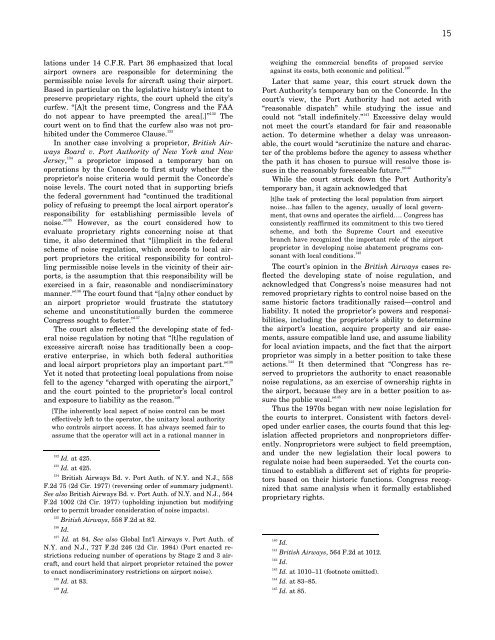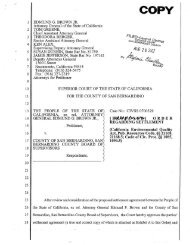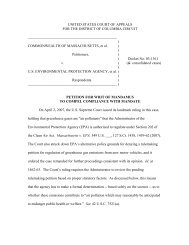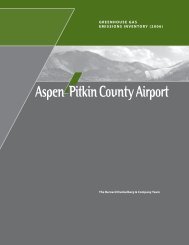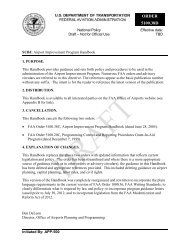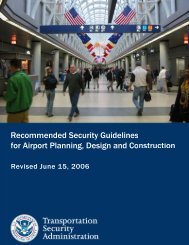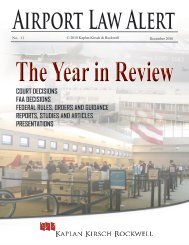ACRP Legal Research Digest 10
ACRP Legal Research Digest 10
ACRP Legal Research Digest 10
You also want an ePaper? Increase the reach of your titles
YUMPU automatically turns print PDFs into web optimized ePapers that Google loves.
15<br />
lations under 14 C.F.R. Part 36 emphasized that local<br />
airport owners are responsible for determining the<br />
permissible noise levels for aircraft using their airport.<br />
Based in particular on the legislative history’s intent to<br />
preserve proprietary rights, the court upheld the city’s<br />
curfew. “[A]t the present time, Congress and the FAA<br />
do not appear to have preempted the area[.]” 132<br />
The<br />
court went on to find that the curfew also was not prohibited<br />
under the Commerce Clause. 133<br />
In another case involving a proprietor, British Airways<br />
Board v. Port Authority of New York and New<br />
Jersey, 134<br />
a proprietor imposed a temporary ban on<br />
operations by the Concorde to first study whether the<br />
proprietor’s noise criteria would permit the Concorde’s<br />
noise levels. The court noted that in supporting briefs<br />
the federal government had “continued the traditional<br />
policy of refusing to preempt the local airport operator’s<br />
responsibility for establishing permissible levels of<br />
noise.” 135<br />
However, as the court considered how to<br />
evaluate proprietary rights concerning noise at that<br />
time, it also determined that “[i]mplicit in the federal<br />
scheme of noise regulation, which accords to local airport<br />
proprietors the critical responsibility for controlling<br />
permissible noise levels in the vicinity of their airports,<br />
is the assumption that this responsibility will be<br />
exercised in a fair, reasonable and nondiscriminatory<br />
manner.” 136 The court found that “[a]ny other conduct by<br />
an airport proprietor would frustrate the statutory<br />
scheme and unconstitutionally burden the commerce<br />
Congress sought to foster.” 137<br />
The court also reflected the developing state of federal<br />
noise regulation by noting that “[t]he regulation of<br />
excessive aircraft noise has traditionally been a cooperative<br />
enterprise, in which both federal authorities<br />
and local airport proprietors play an important part.” 138<br />
Yet it noted that protecting local populations from noise<br />
fell to the agency “charged with operating the airport,”<br />
and the court pointed to the proprietor’s local control<br />
and exposure to liability as the reason. 139<br />
[T]he inherently local aspect of noise control can be most<br />
effectively left to the operator, the unitary local authority<br />
who controls airport access. It has always seemed fair to<br />
assume that the operator will act in a rational manner in<br />
132<br />
Id. at 425.<br />
133<br />
Id. at 425.<br />
134<br />
British Airways Bd. v. Port Auth. of N.Y. and N.J., 558<br />
F.2d 75 (2d Cir. 1977) (reversing order of summary judgment).<br />
See also British Airways Bd. v. Port Auth. of N.Y. and N.J., 564<br />
F.2d <strong>10</strong>02 (2d Cir. 1977) (upholding injunction but modifying<br />
order to permit broader consideration of noise impacts).<br />
135<br />
British Airways, 558 F.2d at 82.<br />
136<br />
Id.<br />
137<br />
Id. at 84. See also Global Int’l Airways v. Port Auth. of<br />
N.Y. and N.J., 727 F.2d 246 (2d Cir. 1984) (Port enacted restrictions<br />
reducing number of operations by Stage 2 and 3 aircraft,<br />
and court held that airport proprietor retained the power<br />
to enact nondiscriminatory restrictions on airport noise).<br />
138<br />
Id. at 83.<br />
139<br />
Id.<br />
weighing the commercial benefits of proposed service<br />
against its costs, both economic and political. 140<br />
Later that same year, this court struck down the<br />
Port Authority’s temporary ban on the Concorde. In the<br />
court’s view, the Port Authority had not acted with<br />
“reasonable dispatch” while studying the issue and<br />
could not “stall indefinitely.” 141<br />
Excessive delay would<br />
not meet the court’s standard for fair and reasonable<br />
action. To determine whether a delay was unreasonable,<br />
the court would “scrutinize the nature and character<br />
of the problems before the agency to assess whether<br />
the path it has chosen to pursue will resolve those issues<br />
in the reasonably foreseeable future.” 142<br />
While the court struck down the Port Authority’s<br />
temporary ban, it again acknowledged that<br />
[t]he task of protecting the local population from airport<br />
noise…has fallen to the agency, usually of local government,<br />
that owns and operates the airfield…. Congress has<br />
consistently reaffirmed its commitment to this two tiered<br />
scheme, and both the Supreme Court and executive<br />
branch have recognized the important role of the airport<br />
proprietor in developing noise abatement programs consonant<br />
with local conditions. 143<br />
The court’s opinion in the British Airways cases reflected<br />
the developing state of noise regulation, and<br />
acknowledged that Congress’s noise measures had not<br />
removed proprietary rights to control noise based on the<br />
same historic factors traditionally raised—control and<br />
liability. It noted the proprietor’s powers and responsibilities,<br />
including the proprietor’s ability to determine<br />
the airport’s location, acquire property and air easements,<br />
assure compatible land use, and assume liability<br />
for local aviation impacts, and the fact that the airport<br />
proprietor was simply in a better position to take these<br />
actions. 144<br />
It then determined that “Congress has reserved<br />
to proprietors the authority to enact reasonable<br />
noise regulations, as an exercise of ownership rights in<br />
the airport, because they are in a better position to assure<br />
the public weal.” 145<br />
Thus the 1970s began with new noise legislation for<br />
the courts to interpret. Consistent with factors developed<br />
under earlier cases, the courts found that this legislation<br />
affected proprietors and nonproprietors differently.<br />
Nonproprietors were subject to field preemption,<br />
and under the new legislation their local powers to<br />
regulate noise had been superseded. Yet the courts continued<br />
to establish a different set of rights for proprietors<br />
based on their historic functions. Congress recognized<br />
that same analysis when it formally established<br />
proprietary rights.<br />
140<br />
Id.<br />
141<br />
British Airways, 564 F.2d at <strong>10</strong>12.<br />
142<br />
Id.<br />
143<br />
Id. at <strong>10</strong><strong>10</strong>–11 (footnote omitted).<br />
144<br />
Id. at 83–85.<br />
145<br />
Id. at 85.


